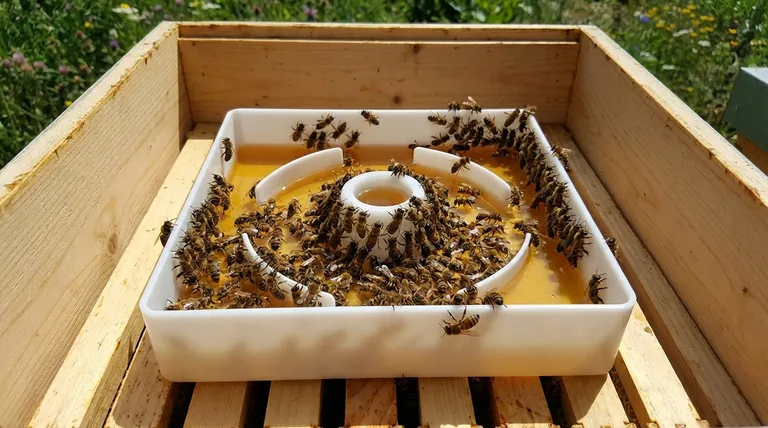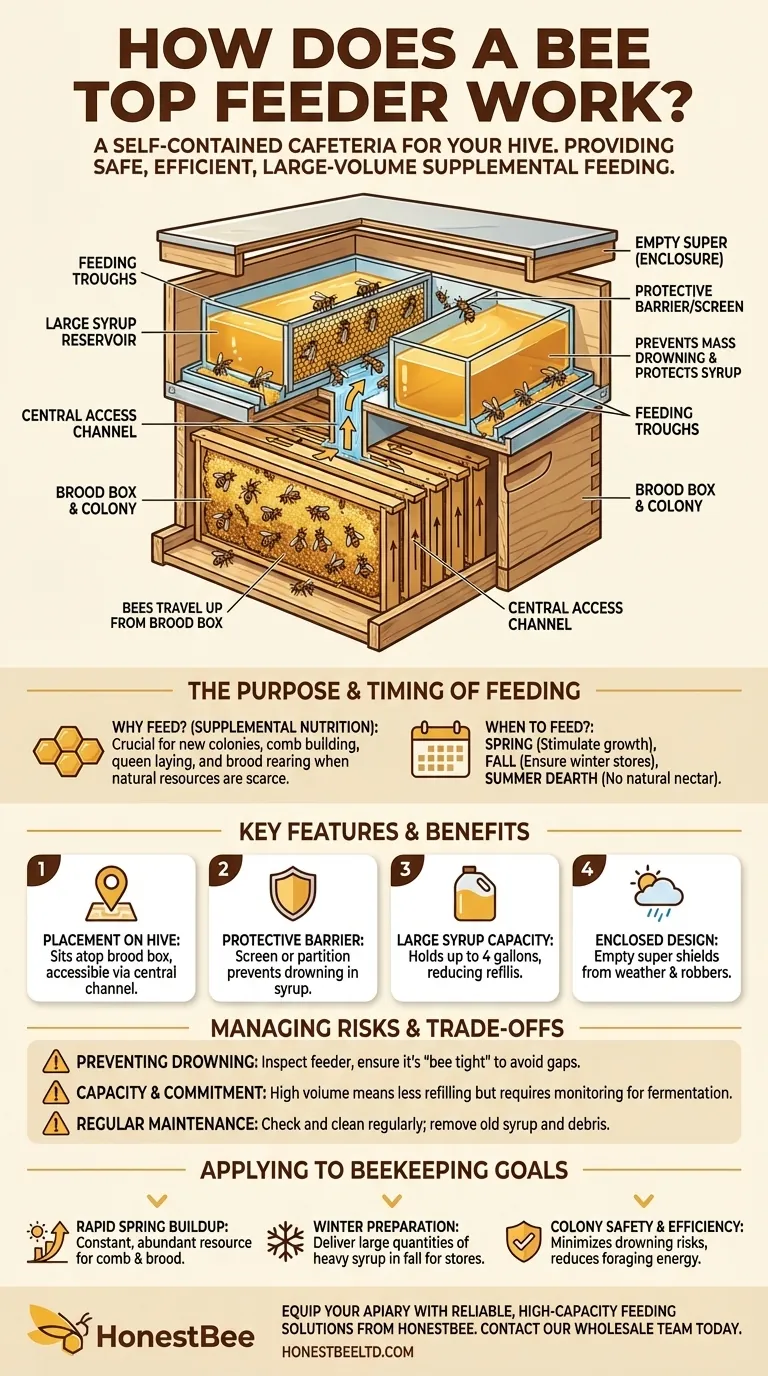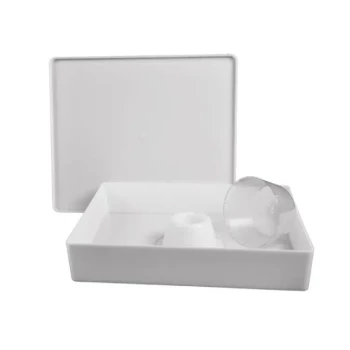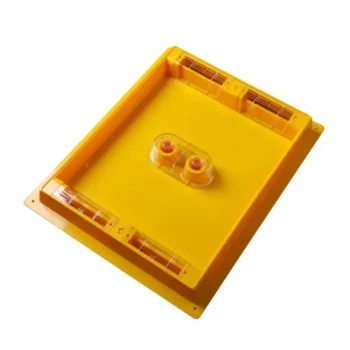At its core, a bee top feeder is a self-contained cafeteria placed on top of your hive. It works by creating a safe and specific path for bees to access a large reservoir of sugar syrup. Bees travel up from the brood box through a central channel, climb over a protective barrier or screen, and then descend into troughs to feed without ever entering the main body of the liquid.
The top feeder's design solves two critical problems: it prevents the mass drowning common in simpler feeders and it protects the syrup from outside robbers and the elements, providing a large, stable food source for the colony.

The Purpose of Supplemental Feeding
Why Your Colony May Need Help
A bee feeder provides supplemental nutrition—typically sugar water or syrup—when natural nectar sources are scarce. This is crucial for newly installed colonies that lack honey stores and drawn comb.
Feeding helps a new colony build comb, allows the queen to lay eggs, and ensures the nurse bees can produce the royal jelly needed to raise brood. It provides the raw energy required for the colony to establish itself and grow.
When to Feed Your Bees
Beekeepers typically use feeders in the spring to stimulate colony growth after winter and in the fall to ensure the bees have sufficient food stores to survive the cold months ahead. They are also used during a "dearth," a period in summer when flowers are not blooming and natural nectar is unavailable.
How a Top Feeder Works: A Mechanical Breakdown
Placement and Installation
The top feeder is placed directly on top of the uppermost hive box, replacing the inner cover. An empty hive box (a "super") is then placed around the feeder to enclose it, and the outer cover is placed on top of that empty box. This shields the feeder from weather and prevents robbing by other insects.
The Central Access Channel
The design features a central opening or a set of slots that align with the space between frames in the hive below. Bees climb up from the colony directly into this protected channel, containing them in a specific area of the feeder.
The Protective Barrier
Once inside the channel, the bees must climb up and over a partition. Many top feeders have a screen or hardware cloth over this access area. This barrier is the feeder's most important safety feature, as it prevents bees from flying directly into the syrup reservoir.
The Syrup Reservoir
After crossing the barrier, bees crawl down into the designated feeding troughs, which hold the syrup. They can safely access the liquid from the sides, drinking to their fill before making the return trip to the hive. As the syrup level drops, the bees simply crawl further down the wall of the trough.
Understanding the Trade-offs and Risks
Preventing Drowning
The most significant risk with any feeder is bee drowning. With a top feeder, this happens if the protective barrier is not "bee tight." If bees can find a way to access the syrup reservoir from underneath or through a gap, they will fall in and drown. You must inspect your feeder to ensure all seams are sealed and the screen is secure.
Capacity and Commitment
Top feeders hold a large volume of syrup, often up to four gallons. This high capacity is excellent for reducing the frequency of refills but also means you are committing a large amount of sugar water to the hive. In fluctuating temperatures, this can lead to fermentation if not consumed quickly.
Regular Maintenance
Like any piece of equipment, a top feeder must be checked and cleaned regularly. Old syrup can spoil or crystallize, and drowned bees must be removed. Consistent maintenance ensures the food source remains safe and appealing for your colony.
Applying This to Your Beekeeping Goals
A top feeder is a powerful tool when used correctly. Here is how to decide if it's right for your objective:
- If your primary focus is rapid spring buildup: The high capacity of a top feeder provides the constant, abundant resource bees need to build comb and raise brood quickly.
- If your primary focus is winter preparation: A top feeder allows you to deliver large quantities of heavy syrup in the fall, helping the colony build its winter stores with minimal disturbance.
- If your primary focus is colony safety and efficiency: The feeder's design minimizes drowning risks and reduces the energy bees must expend to find and transport food.
By understanding the mechanics of a top feeder, you can effectively support your colony's health and productivity.
Summary Table:
| Feature | Benefit |
|---|---|
| Placement on Hive | Sits atop the brood box, accessible via a central channel. |
| Protective Barrier | Screen or partition prevents bees from drowning in the syrup reservoir. |
| Large Syrup Capacity | Holds up to 4 gallons, reducing refill frequency. |
| Enclosed Design | An empty super box surrounds it, shielding from weather and robbers. |
| Key Use Cases | Ideal for spring buildup, fall feeding, and summer dearth periods. |
Equip your apiary with reliable, high-capacity feeding solutions from HONESTBEE.
As a trusted supplier for commercial apiaries and beekeeping equipment distributors, we provide the durable, efficient tools you need to support colony health and maximize productivity. Our top feeders are designed for the demands of professional beekeeping.
Contact our wholesale team today to discuss your needs and discover how our beekeeping supplies can benefit your operation.
Visual Guide

Related Products
- HONESTBEE Professional Hive Top Bee Feeder Feeding Solution
- Professional Hive Top Bee Feeder for Beekeeping
- HONESTBEE Round Hive Top Bee Feeder for Syrup
- Rapid Bee Feeder White Plastic 2L Round Top Feeder for 8 or 10-Frame Bee Hives
- HONESTBEE Entrance Bee Feeder Professional Hive Nutrition Solution for Beekeeping
People Also Ask
- What should be done with feeders and equipment after feeding bees? Essential Steps for Apiary Health
- What features make top feeders a reliable choice for beekeepers? A Guide to Safe, Efficient Hive Nutrition
- How is the plywood floor fitted into the hive-top feeder? Ensure Longevity with a Floating Floor Design
- What is a top feeder for bees? Maximize Colony Health with Efficient Feeding
- Do I need an inner cover with a hive top feeder? Optimize Your Hive Setup for Healthy Bees



















